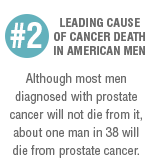 Prostate cancer is the most commonly diagnosed cancer in males. Approximately 3 million men in the United States have prostate cancer and over 221,000 new cases are diagnosed each year. While the average age at diagnosis is 66, 40% of cases occur before 65 years of age.
Prostate cancer is the most commonly diagnosed cancer in males. Approximately 3 million men in the United States have prostate cancer and over 221,000 new cases are diagnosed each year. While the average age at diagnosis is 66, 40% of cases occur before 65 years of age.Prostate cancer is also the second leading cause of cancer death in men. However, most men who have prostate cancer will not die from prostate cancer or experience symptoms. Prostate cancer has an almost 100% five-year survival rate and a 99% 10-year survival rate. This high survival rate raises the question: do the available screening tools lead to overtreatment of a disease that would otherwise not cause problems in many men?
Screening Methods
 Since its introduction in 1986, the Prostate Specific Antigen (PSA) blood test is the most common, non-invasive screening test available for prostate cancer. Until recently, yearly PSA tests were encouraged for men starting at age 50 to check for elevated levels of PSA—a possible indicator of prostate cancer.
Since its introduction in 1986, the Prostate Specific Antigen (PSA) blood test is the most common, non-invasive screening test available for prostate cancer. Until recently, yearly PSA tests were encouraged for men starting at age 50 to check for elevated levels of PSA—a possible indicator of prostate cancer.While this method of screening has increased the number of prostate cancer diagnoses, has helped diagnose prostate cancer at an earlier stage, and has resulted in fewer prostate cancer deaths, it remains controversial because of the cost and danger of overtreatment of disease that would not necessarily cause problems. Unfortunately, questionable results received from the PSA test have led to large quantities of men with prostate cancer receiving aggressive, often unnecessary, forms of treatment (which can include hormonal, surgical, or radiation therapies). While these therapies can be beneficial to some groups of men with prostate cancer, many men whose prostate cancers are localized to the prostate, will not cause harm if left alone, and do not need to undergo aggressive treatment.
 Unfortunately, more effective, non-invasive methods of screening for prostate cancer besides PSA testing do not currently exist. Screening with a digital rectal exam is safe and inexpensive, but is a relatively poor way of screening for prostate cancer compared to PSA testing. In patients with an abnormal PSA level, there are other tests that can be done such as PCA3 (which involves a rectal examination and urine test) and Prostate Health Index (which is a new combination of three blood tests that results in a “PHI” score) to further refine the screening process. Magnetic resonance imaging (MRI) may also be useful as a screening tool prior to conducting a prostate biopsy.
Unfortunately, more effective, non-invasive methods of screening for prostate cancer besides PSA testing do not currently exist. Screening with a digital rectal exam is safe and inexpensive, but is a relatively poor way of screening for prostate cancer compared to PSA testing. In patients with an abnormal PSA level, there are other tests that can be done such as PCA3 (which involves a rectal examination and urine test) and Prostate Health Index (which is a new combination of three blood tests that results in a “PHI” score) to further refine the screening process. Magnetic resonance imaging (MRI) may also be useful as a screening tool prior to conducting a prostate biopsy.Diagnosing Prostate Cancer
 Prostate biopsy is the only way to definitively diagnose prostate cancer. While invasive and anxiety-inducing in many patients, the procedure only takes about 10 minutes, and has few serious complications. Almost all patients who have done a biopsy in the office awake will choose to undergo the procedure again in the office awake if they need another biopsy.
Prostate biopsy is the only way to definitively diagnose prostate cancer. While invasive and anxiety-inducing in many patients, the procedure only takes about 10 minutes, and has few serious complications. Almost all patients who have done a biopsy in the office awake will choose to undergo the procedure again in the office awake if they need another biopsy.Regardless of the high survival rate, the high prevalence means that many men still die from prostate cancer. Because of the costs— personal and monetary—of dying from prostate cancer, most people feel that patients and their physicians should make an attempt to diagnose prostate cancer before it spreads to other organs in the body to prevent human suffering. It is important to note that earlier detection of prostate cancer in the past few decades has been accompanied by a greater reduction in mortality than seen with any other cancer.
Conclusions and Recommendations
 Healthy men (men who have a life expectancy of ten years or more) who are approaching or have reached 50 years of age should have a discussion with their physician to determine the best prostate cancer screening plan for them. It is important than older men and men who are at a high risk of prostate cancer get screened: have a DRE and PSA test—then discuss the results with your doctor to decide whether or not further testing is indicated or necessary.
Healthy men (men who have a life expectancy of ten years or more) who are approaching or have reached 50 years of age should have a discussion with their physician to determine the best prostate cancer screening plan for them. It is important than older men and men who are at a high risk of prostate cancer get screened: have a DRE and PSA test—then discuss the results with your doctor to decide whether or not further testing is indicated or necessary.Dr. Michael Kaempf, Urologist
Dr. Michael Kaempf is a board-certified Urologist at The Oregon Clinic. He specializes in robotic minimally invasive surgery, prostate cancer, kidney stones, and other urologic medical conditions. Click here to schedule an appointment with one of our board-certified Urologists.